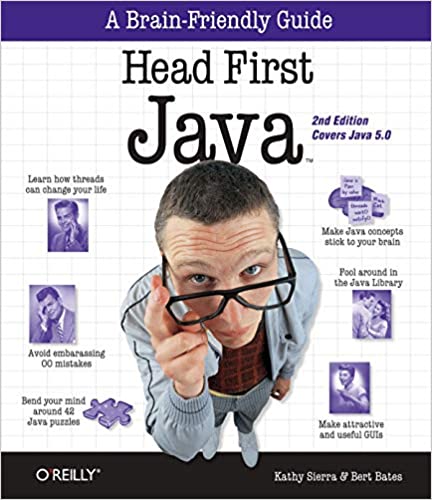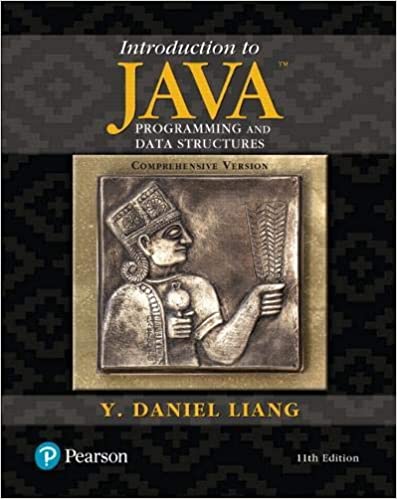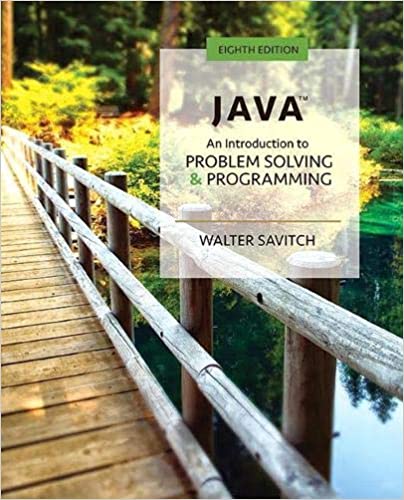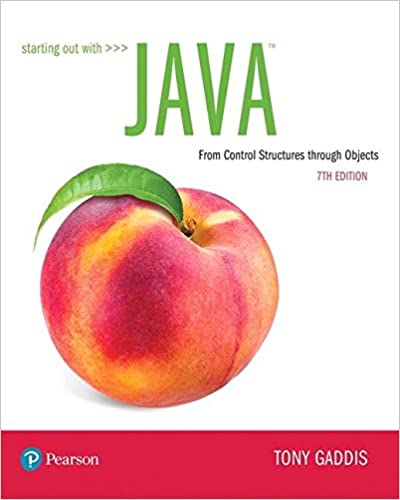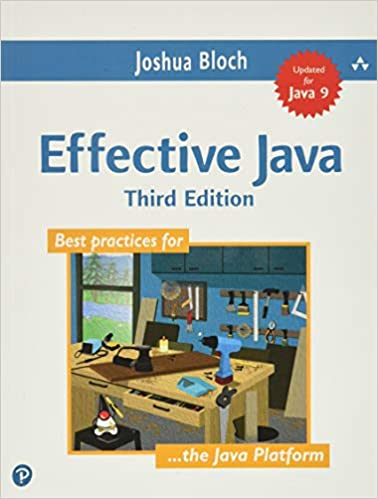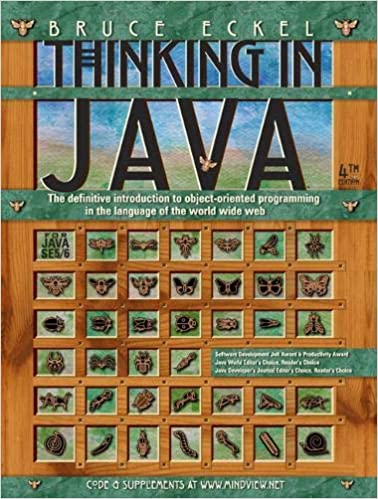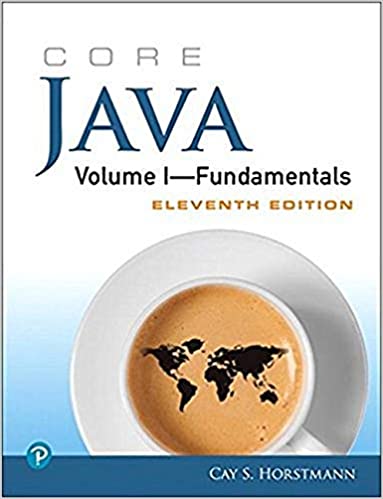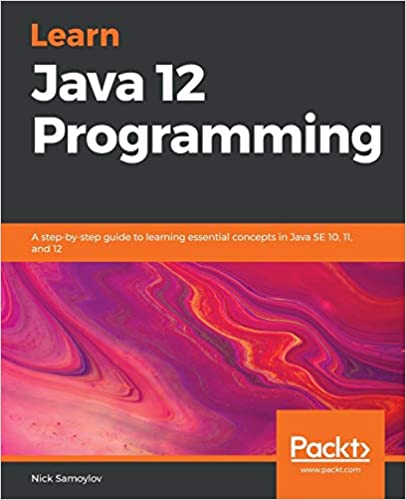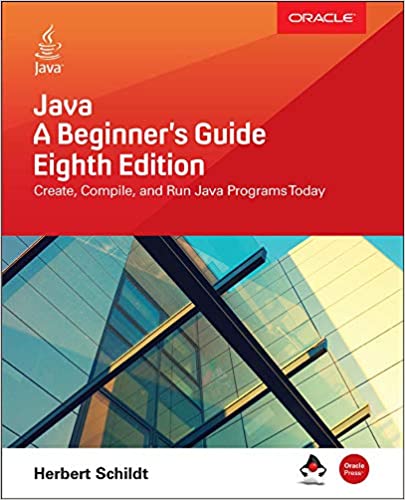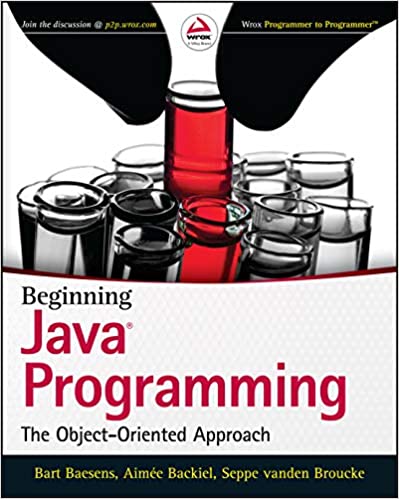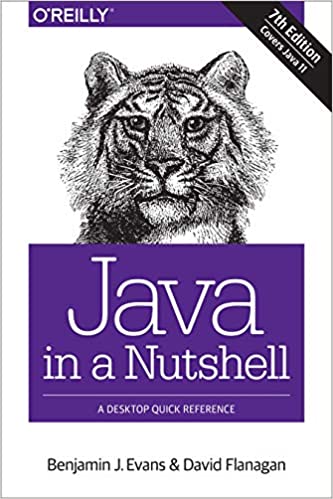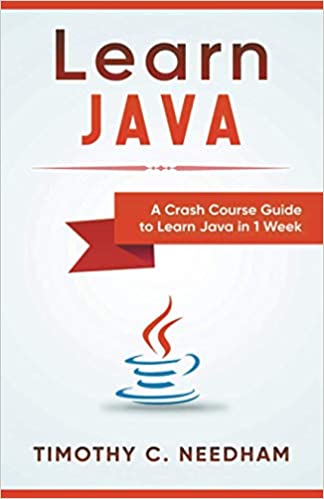According to Indeed, the average Java developer salary in the U.S. is $103,183 per year.
So how can you start learning this financially rewarding programming language?
Well, programming books are often the way to go.
And we’re looking at 13 of the best Java books for beginners so you can start learning Java today.
This post contains affiliate links. I may receive compensation if you buy something. Read my disclosure for more details.
TLDR: Best Java Books for Beginners in 2020
Out of the 13 best Java books for beginners, we chose the following:
🔥 Best Overall 🔥
Head First Java, 2nd Edition
💥 Best for Absolute Newbies 💥
Java: An Introduction to Problem Solving and Programming
💸 Best Value 💸
Thinking in Java, 4th Edition
Best Java Books for Beginners
1. Head First Java, 2nd Edition
Head First Java by Kathy Sierra and Bert Bates is one of the best Java books for beginners. It uses proven methods to help you learn the material and make it stick.
Instead of walls of boring text, you’ll learn with tons of visuals and helpful notes. There are also plenty of puzzles to keep your brain engaged while learning Java.
You’ll start by learning Java fundamentals, but will also learn some advanced Java concepts including:
- threads
- network sockets
- distributed programming with RMI
Plus you’ll get a complete introduction to object-oriented programming in Java.
In addition to learning Java, you’ll also learn how to think like a Java programmer.
Head First Java teaches Java 5.0. So while it’s not the most recent version of Java, it’s still one of the best books to learn the fundamentals.
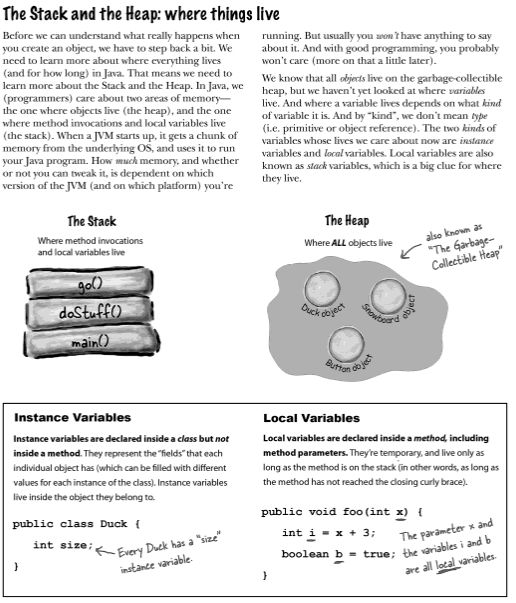
Looking for a good course to learn Java? Check out Learn Java from Scratch on Educative.io.
🔥 Geena’s Hot Take
When there’s a Head First book on a particular subject, I will always recommend it first.
And that includes Head First Java.
They break things down into easy-to-learn, digestible pieces. There are tons of illustrations and even more notes (the notes are super helpful).
It’s almost like you can feel your brain learning.
2. Introduction to Java Programming and Data Structures, Comprehensive Version
Introduction to Java Programming and Data Structures by Y. Daniel Liang is a textbook packed with Java fundamentals.
First you’ll learn about problem solving as it relates to programming. Then you’ll learn about object-oriented programming.
In addition, you’ll learn about the graphical user interface (GUI) using JavaFX. Next you’ll explore web programming.
Finally, Introduction to Java extensively covers data structures.
Throughout the book you’ll find plenty of examples, illustrations and exercises.
Interested in Introduction to Java but don’t have the time to go through 1200+ pages? Check out Introduction to Java, Brief Version.
Knowledge oozes from this text!
– Darrin Anderson, Customer
3. Java: An Introduction to Problem Solving and Programming
Java: An Introduction to Problem Solving and Programming by Walter Savitch is another Java textbook. It’s geared towards beginners with no prior programming experience.
With a strong focus on object-oriented programming, you’ll find objects covered throughout the text.
You’ll also learn about:
- design
- testing
- debugging
- inheritance
- exception handling
And beyond.
Throughout the book, you’ll find ample examples and case studies to reinforce concepts.
So if you learn better in an academic setting, Java: An Introduction to Problem Solving and Programming might be the right Java book for you.
4. Starting Out with Java: From Control Structures through Objects
Starting Out with Java: From Control Structures Through Objects is part of a series by Tony Gaddis.
In this step-by-step introduction to Java, you’ll learn about everything from procedural programming to object-oriented programming.
Every chapter contains code snippets, real-world examples and exercises.
In this 7th edition, you’ll focus on JavaFX as the standard GUI library.
Starting Out with Java covers Java fundamentals as well as problem-solving processes.
Already have some programming under your belt but want to learn Java? Check out Java for Programmers on Educative.io.
5. Effective Java, Third Edition
Effective Java, Third Edition by Joshua Bloch covers Java 9. And with that comes new design patterns and language.
Some of what you’ll learn includes:
- creating and destroying objects
- classes and interfaces
- enums and annotations
- lambdas and streams
- exceptions
And more.
Each chapter starts off with a short essay that provides some insight into Java fundamentals. Then you’ll look at code examples to reinforce those concepts.
So you’ll learn what and what not to do, and why. This includes best practices for objects, classes, libraries and beyond.
You’ll also learn how to avoid traps within Java.
Finally, you’ll learn about fundamental Java libraries such as java.lang and java.util.
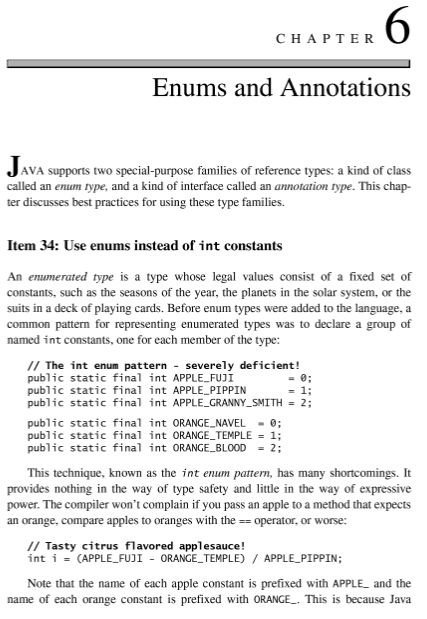
6. Thinking in Java, 4th Edition
Even though it was published in 2006, Thinking in Java by Bruce Eckel is still widely regarded as one of the best Java books for beginners.
In fact, it’s won awards for being such a good reference.
There’s a strong focus on object-oriented programming, and you’ll learn concepts step-by-step.
Using hundreds of example programs, you’ll learn valuable techniques to build applications.
So you’ll start by learning the fundamentals of Java programming. This includes:
- program flow
- initialization
- cleanup
- polymorphism
And beyond.
Then you’ll learn about exception handling and run-time type identification.
Next, Thinking in Java covers server-side Java like database integration and security.
You’ll also learn about GUI libraries.
Throughout Thinking in Java, you’ll also learn the hows and whys of how the Java programming language works.
Thinking in Java should be read cover to cover by every Java programmer, then kept close at hand for frequent reference.
– Jim Pleger, Loudoun County (Virginia) Government
7. Core Java Volume I–Fundamentals, 11th Edition
Covering Java SE 9, 10 and 11, Core Java Volume I–Fundamentals by Cay Horstmann shows you how to write code that’s easier to manage.
First you’ll learn how to master foundational techniques. Then you’ll learn best practices to write better Java code.
You’ll also learn how to use generic programming to write safer and reusable code.
In addition, you’ll examine:
- exception handling
- debugging
- lambda expressions
- inner classes
And beyond.
Using standard collections, you’ll explore how to improve the performance and efficiency of your Java code.
You’ll also learn how to use Swing to build cross-platform GUIs.
Note: This book is strongly recommended for readers with some prior programming experience, particularly C++.
Once you get your Java fundamentals down, you can move onto Core Java, Volume II–Advanced Features.
8. Learn Java 12 Programming
Learn Java 12 Programming by Nick Samoylov has a strong focus on object-oriented, functional, and reactive programming in Java SE 10, 11 and 12.
But first you’ll start with the absolute basics: installing the Java Development Kit.
Then you’ll dive into core programming concepts such as:
- concurrency
- error handling
- GUI programming
And more.
You’ll also learn about data structures and how they’re used in Java.
Then you’ll move onto more advanced concepts like database management and network programming.
By the end of Learn Java 12 Programming, you’ll be able to write high-quality, reusable code.
This book is ideal for absolute beginners. So no prior programming experience is required.
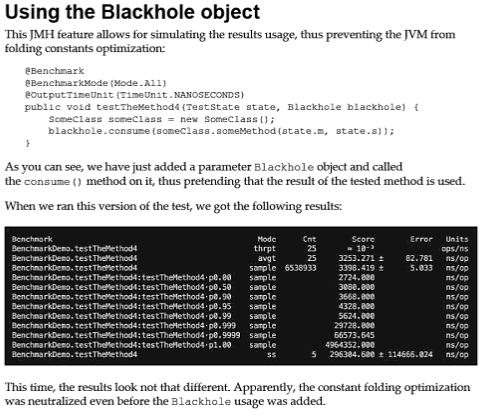
Still trying to decide on which Java course to take? Try Learn Java on Codecademy Pro.
9. Think Java: How to Think Like a Computer Scientist
Think Java: How to Think Like a Computer Scientist by Allen Downey and Chris Mayfield is a hands-on introduction to computer programming. Using casual language, you’ll feel more at ease while learning the fundamentals of Java.
You’ll start by learning the absolute basics like:
- variables and operators
- loops and strings
- arrays and references
- recursive methods
And so on.
From there you’ll work your way up to more advanced concepts like object-oriented techniques.
Then you’ll practice debugging.
Each chapter in Think Java represents one week of college coursework. There are plenty of exercises to work on throughout the book.
There are also tons of examples to clarify concepts.
10. Java: A Beginner’s Guide, Eighth Edition
Java: A Beginner’s Guide, Eighth Edition by Herbert Schlidt is fully updated for Java 11.
First you’ll begin with the basics like how to compile and run a Java program. Then you’ll learn core Java keywords and syntax.
Then you’ll learn about more advanced concepts like:
- multithreading
- lambda expressions
- modules
- Swing
And beyond.
Java: A Beginner’s Guide contains question and answer sections. These include tips and bonus info. There are also plenty of exercises and quizzes to reinforce concepts.
In addition, the syntax throughout the book is annotated. So it includes sample code and commentary on the programming techniques.
11. Beginning Java Programming: The Object-Oriented Approach
Beginning Java Programming by Bart Baesens, Aimee Backiel, et al. is a comprehensive Java guide. It’s filled to the brim with:
- step-by-step instructions
- exercises
- case studies
- examples
So naturally you’ll start with a general introduction to Java programming basics like setting up your developer environment.
Then you’ll graduate to more advanced concepts such as object-oriented programming, control flow and exception handling. Plus you’ll learn about the GUI.
Every chapter creates scenarios and exercises based on real-world businesses. And in the final chapter, you’ll work with case studies that combine all the concepts you’ve learned.
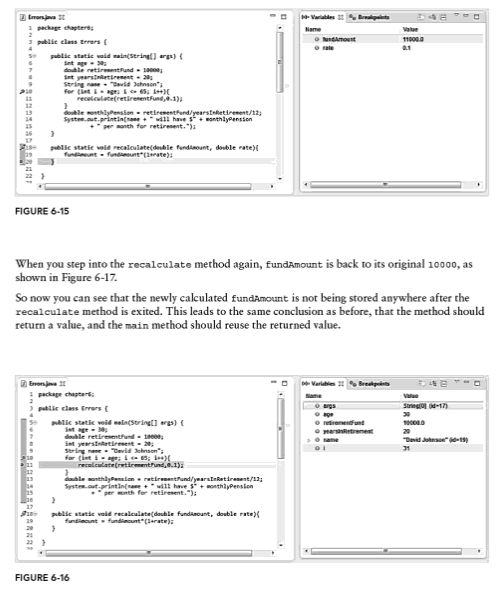
12. Java in a Nutshell: A Desktop Quick Reference
Java in a Nutshell by Benjamin Evans and David Flanagan covers Java 9, 10 and 11. While it’s useful for experienced developers, this is also a useful reference for beginners.
The first part of the book offers an accelerated introduction to Java programming. Plus you’ll learn about the core runtime aspects of Java.
So you’ll learn about:
- object-oriented programming
- generics, enumerations, lambda expressions
- memory and concurrency
- development tools
And more.
Then you’ll find that the second part of the book is a reference for core concepts and APIs in Java. Here’s where you’ll learn how to perform actual programming work in Java.
Java in a Nutshell should not be the only book you read as a Java beginner. Rather, it can be a helpful addition to your main study materials.
Interested in taking a learning track? Sign up for the Learn Java track on Treehouse.
13. Learn Java: A Crash Course Guide to Learn Java in 1 Week
Learn Java by Timothy Needham claims to be able to teach you Java in 1 week. But keep in mind, there are several factors that will determine this such as learning pace and how much time you are able to dedicate to learning.
And it won’t give you a complete education, but it will teach you some core concepts in Java 10.
Some of the fundamentals you’ll learn include:
- variables
- loops
- conditions
- arrays
- operators
And beyond.
Then you’ll learn about object-oriented programming concepts like encapsulation and polymorphism.
Learn Java is one of the best Java books for beginners who are motivated to learn at an accelerated rate.
Best Java Books for Beginners: Conclusion
Today we showed your our best Java books for beginners. And three came out on top:
Best Overall
Head First Java, 2nd Edition
Best for Absolute Newbies
Java: An Introduction to Problem Solving and Programming
Best Value
Thinking in Java, 4th Edition
So whether you want the best of the best, are on a budget, or need something newbie-friendly, we think there’s a Java book for everyone.
Up Next:
- 13 Best Technical Interview Books This Year [Technical Interview Prep]
- 15 Best Software Architecture Books [Become a Software Architect]
- 19 Best Books for Data Structures [Learn Data Structures and Algorithms]
- 11 Best Coding Interview Books in [Pass the Coding Interview]
- Codecademy vs Udemy [The Platform Battle of This Year]
What are the best Java books for beginners?
For the best Java books for beginners, we picked three. For best overall, we think Head First Java is the way to go. For absolute newbies, Java: An Introduction to Problem Solving and Programming has a beginner-friendly teaching style. And for best value, we think Thinking in Java, 4th Edition is the winner.
Is the book Head First Java worth it?
Yes, we think Head First Java is Worth it. It uses proven methods to help you learn the material and make it stick. Instead of walls of boring text, you’ll learn with tons of visuals and helpful notes. There are also plenty of puzzles to keep your brain engaged while learning Java. You’ll start by learning Java fundamentals, but will also learn some advanced Java concepts including threads, network sockets, and distributed programming with RMI. Plus you’ll get a complete introduction to object-oriented programming in Java. In addition to learning Java, you’ll also learn how to think like a Java programmer. Head First Java teaches Java 5.0. So while it’s not the most recent version of Java, it’s still one of the best books to learn the fundamentals.
Is the book Thinking in Java worth it?
We think so. Even though it was published in 2006, Thinking in Java by Bruce Eckel is still widely regarded as one of the best Java books for beginners. In fact, it’s won awards for being such a good reference. There’s a strong focus on object-oriented programming, you’ll learn concepts step-by-step. Using hundreds of example programs, you’ll learn valuable techniques to build applications. So you’ll start by learning the fundamentals of Java programming. This includes program flow, initialization, cleanup, polymorphism and beyond. Then you’ll learn about exception handling and run-time type identification. Next, Thinking in Java covers server-side Java like database integration and security.
You’ll also learn about GUI libraries. Throughout Thinking in Java, you’ll also learn the hows and whys of how the Java programming language works.
![13 best java books for beginners this year [learn java programming]](https://realtoughcandy.com/wp-content/uploads/2021/03/cover-best-java-books-for-beginners-1024x576.jpg)
